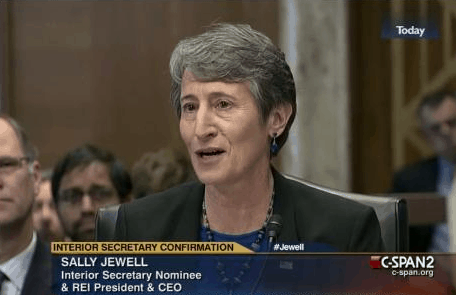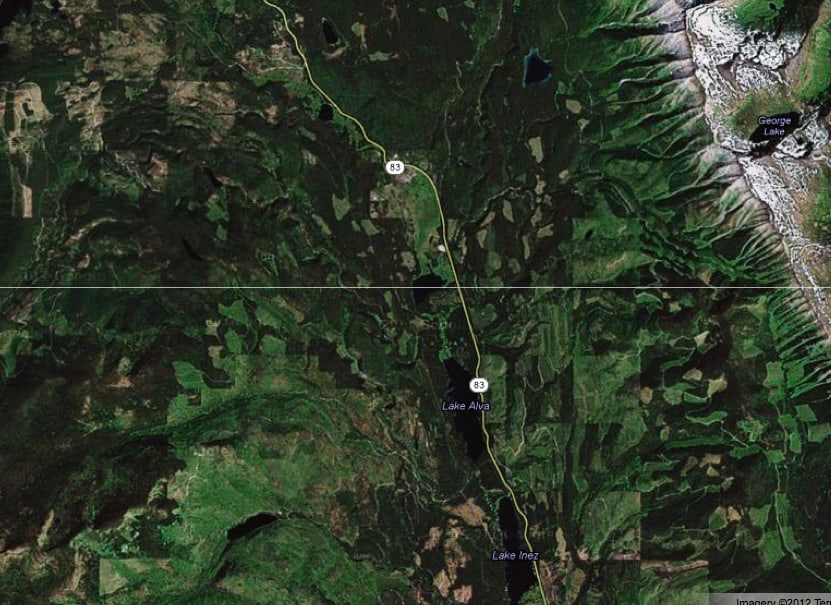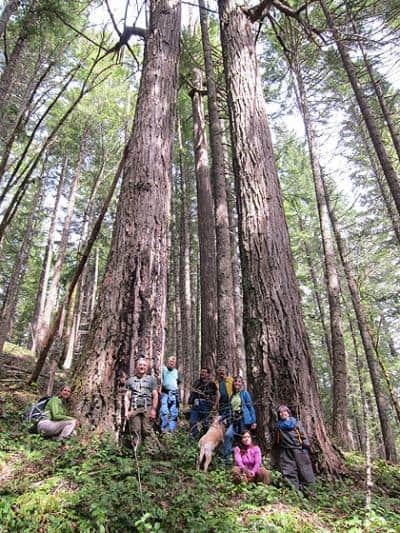 Ken Cole over at The Wildlife News pointed out that Sally Jewell, nominee for Secretary of the Interior, has provides her written answers to about 200 questions asked of her by Senate ENR committee members. Download Jewell’s written responses here.
Ken Cole over at The Wildlife News pointed out that Sally Jewell, nominee for Secretary of the Interior, has provides her written answers to about 200 questions asked of her by Senate ENR committee members. Download Jewell’s written responses here.
The USDA Homogenization Project
No, we are not talking dairy here..but new Department Direction ( would you think they might have other things to do, given sequestration?)
USDA symbol is the official and sole identity mark for the Department and all agency programs. Agency logos are being phased out and replaced with a standardized signature model to be adopted by all USDA agencies …
USDAlogo-1 the pdf (Bob, you might not want to read this…it’s very bureaucratic)
Turns out that a retiree says that this was tried to the Park Service a while back then rescinded due to uproar by employees and retirees.
Here are the two possibilities- 1) Don’t know how this will affect employees. Insensitivity.
2) Don’t care how this will affect employees. Intentional Irritation (with some end in mind?).
If I were a Machiavellian thinker, I would think all this was an elaborate plot by the Obama Administration to pry our achy and arthritic retiree fingers from the attachment of the stodgy to the FS being in USDA, when it would make sense and save the taxpayer beaucoup bucks to move the FS to Interior. If so, it’s working, because many retirees I’ve spoken with now see this transfer in a favorable light.
But one of my favorite things is to see the language of retirees released from the bureaucratic mush of official written statements.
From Tom Hamilton (formerly Associate Deputy Chief for R&D)
“The USDA symbol is the ultimate example of permanent deforestation.”
Is the World Failing At Conservation? Live Chat with AAAS
This sounds like it might be interesting, although I think “conservation” is really about policy and not a “science” issue. Oh well… It’s nice to look up from our fuels treatment projects once in a while to the bigger picture.
I don’t think you have to be a AAAS member to listen in..
Mountain bikers, environmentalists clash over Angeles National Forest plan
The Mountain Biking Community.. (paraphrase of Niemoller)
First they came for the loggers,
and I didn’t speak out because I wasn’t a logger (and timber industry is “corporate.)
Then they came for the people who wanted fuel treatments,
and I didn’t speak out because I didn’t live in a WUI (and they shouldn’t really be living there)
Then they came for the OHV users,
and I didn’t speak out because I didn’t have an OHV (and those things are noisy and smelly)
Then they came for me,
and there was no one left to speak for me.
Here’s the link.
I don’t get the thing about wheelchairs based on the story.
Collaborative Learning on EA vs. EIS for Vegetation Projects
This is a test. If this works everyone could enter a project or two from his or her own area and then we could compare what happens across the country, and then ask questions.
So the first step is this: Take a look at this spreadsheet in google docs. Check and see if you can edit it and if you think the columns are the right ones to ask the questions that we might want to ask.
Dead Forests Release Less Carbon Into Atmosphere Than Expected
According to new research, lead by researchers at the University of Arizona, trees killed in the wake of mountain pine beetle infestations in Colorado have released less carbon into the atmosphere than expected. Read about the research and hear from the scientists in this article from the University of Arizona, excerpts of which are also highlighted below. And High Country News wins the award for best headline of the day, “Good news for people who love bad news,” which contains even more information about the new research. What does this new scientific research say about the validity of the oft-repeated claims from the timber industry and others that we have to cut down our forests so that we can”lock up” that carbon in 2 x 4’s?
___________________
Massive tree die-offs release less carbon into the atmosphere than previously thought, new research led by the University of Arizona suggests. Across the world, trees are dying in increasing numbers, most likely in the wake of a climate changing toward drier and warmer conditions, scientists suspect. In western North America, outbreaks of mountain pine beetles (Dendroctonus ponderosae) have killed billions of trees from Mexico to Alaska over the last decade.
Given that large forested areas play crucial roles in taking carbon dioxide out of the atmosphere through photosynthesis and turning it into biomass, an important question is what happens to that stored carbon when large numbers of trees die.
“The general expectation we had was that when trees die on a large scale, it would lead to a big pulse of carbon into the atmosphere through microorganisms metabolizing all that dead wood,” said David Moore, an assistant professor in the School of Natural Resources and the Environment in the UA College of Agriculture and Life Sciences and one of the lead authors of the study, which is published online in the journal Ecology Letters.
“A question we are looking to answer is, ‘How does the carbon dioxide released from the forest into the atmosphere change as you have large scale tree mortality over time?”’ said second lead author Nicole Trahan, a postdoctoral researcher at the University of Colorado, Boulder.
According to co-author Russell Monson, who is the Louise Foucar Marshall Professor in the UA School of Natural Resources and the Environment, forests affect the carbon budget of the atmosphere through two dominant processes: photosynthesis, by which plants take carbon dioxide out of the atmosphere and lock it up in organic compounds, and respiration, by which plants and soil microbes release carbon dioxide back into the atmosphere. The balance of these processes determines whether a particular forest is a carbon source or a carbon sink.
After a massive tree die-off, conventional wisdom has it that a forest would go from carbon sink to carbon source: Since the soil microbes are still around, they are expected to release large amounts of the greenhouse gas carbon dioxide into the atmosphere, where it is thought to accelerate climate change.
“Surprisingly, we couldn’t find a big pulse,” said Moore, who is also a member of the UA Institute of the Environment.
Trahan added: “In the first few years after beetles have come in and killed trees, the carbon release from the surrounding soil actually goes down.”
Large amounts of dead trees, it turns out, hold on to their carbon for a long time and prevent it from quickly being released into the soil or the atmosphere. According to Moore, this might be due to several reasons: First, while trees take up carbon dioxide during the day during photosynthesis, they release some of it at night when they switch to respiration.
“Once the trees are dead, respiration by the trees goes away,” Moore said. “In addition, if you cut off the carbon that a tree put into the soil while it was alive, you reduce the ability of the soil microbes around the roots to respire.”
“After five or six years, there is a buildup of some dead plant material, leaf litter and so on, and that seems to drive the rate of respiration up again. But it never recovers to the point it was before the beetles killed the trees, at least over the span of a decade,” Moore said.
Finally, the trees studied in this project grow at higher elevations, where cooler temperatures slow the decomposition process and thereby carbon-releasing respiration.
“Overall, we discovered that after a tree die-off, the loss of carbon in the soil results less from increased respiration by microbes but more from the fact that trees are no longer sequestering photosynthesized carbon into the soil,” Moore said. “There seems to be a dampening of the carbon cycle rather than a big pulse of carbon release. So even if the forest now goes from a sink to a source of carbon dioxide, it’s not as dramatic of an effect as we thought it would be.”
Colt Summit: Judge dings Forest Service for failure to “prepare a supplemental environmental assessment”

The Colt Summit timber sale – and subsequent lawsuit – on the Lolo National Forest in Montana has been the source of much previous debate on this site, even though this is the first timber sale lawsuit on the Lolo NF in over 6 years. Well, just today the next step in the legal process occurred, as US Federal District Court Judge denied the Forest Service’s motion to dissolve the injunction because the Forest Service failed to “prepare a supplemental environmental assessment,” as the court required. Read the judge’s ruling here, or see the snips below.
The United States Forest Service moves to dissolve the injunction in light of actions that it has taken following remand. The motion is denied. The Court previously granted summary judgment in favor of the Forest Service on a host of issues, all but one. (See doc. 50.) The only fault with the Service’s analysis of the Colt Summit Project was the inadequate cumulative effects analysis for lynx. (Id.) Because of this deficiency, the Court remanded the matter to the Forest Service “so that it may prepare a supplemental environmental assessment consistent with this order and the law.” (Id. at 46.)
The summary judgment order plainly requires the Forest Service to prepare a supplemental environmental assessment (“supplemental EA”). The Service didn’t do so. Instead, it prepared what it called a “supplement to the environmental assessment.” The document is a stand alone document that is, by the Service’s own admission, not a supplemental EA within the meaning of NEPA or the NEPA regulations. See 40 C.F.R. §§ 1502.9, 1508.9–1508.10. Nor, contrary to the Service’s argument, is the “supplement to the environmental assessment” any other type of NEPA document. See 40 C.F.R. § 1508.10. Courts have previously allowed agencies to prepare non-NEPA, supplemental documents on remand, but those circumstances do not apply here….
Instead, where, as here, the Service “present[s] information and analysis that it was required, but according to the finding of the district court, failed to include in its original NEPA documents,” it must prepare a supplemental NEPA document….
Using documents not sanctioned by NEPA to “correct this type of lapse” is “inconsistent with NEPA”:
[I]f the Forest Service were permitted to correct deficiencies in an EA or an EIS by means of an SIR or another non-NEPA procedure, the regulations governing the supplementation of NEPA documents promulgated by the CEQ, as well as the Forest Service’s own rules on the issue, would be superfluous.
The Forest Service’s document does not comply with the Court’s summary judgment order or Ninth Circuit precedent.
The Service makes two arguments in response. First, it argues that the Court has previously allowed the Service to prepare a non-NEPA supplement on remand. See Native Ecosystems Council v. Kimbell, 9:5–cv–110. Be that as it may, the Court in Native Ecosystems Council expressly ordered the Service to “to supplement the EIS.” That isn’t the case here. Here, the summary judgment order expressly requires the Service to prepare a “supplemental environmental assessment.” These are two distinct requirements.
Second, the Forest Service argues that it solicited public comment for the supplement to the EA, so the document should be sufficient. Not so. Providing public comment and following some of NEPA’s other procedures doesn’t make a document a required NEPA document.
The Service’s task on remand was clear: “prepare a supplemental environmental assessment . . . .” (Doc. 50 at 46.) The Service didn’t do that. This decision has nothing to do with the quality or the adequacy of the Service’s lynx analysis. The Service might very well have produced a substantively useful cumulative effects analysis. But, regardless of the quality of the analysis, the Service has to follow the procedures required by law and this Court’s previous order. Until the Service does so, the Court will not consider a motion to dissolve the injunction.
IT IS ORDERED that the U.S. Forest Service’s motion to dissolve the injunction (doc. 60) is DENIED. The Court will not consider a motion to dissolve the injunction until the Forest Service complies with the Court’s previous order requiring the Service to prepare a supplemental environmental assessment and comply with all the requisite procedures. (See doc. 50.)
Dated this 27th day of March 2013.
Wallowa-Whitman road closures still on hold one year later
Actually, more than 6 years. Excerpt from an article in The Oregonian today:
http://www.oregonlive.com/pacific-northwest-news/index.ssf/2013/03/wallowa-whitman_road_closures.html
LA GRANDE — The U.S. Forest Service was on the verge of banning vehicles from 4,000 miles of road in Oregon’s largest national forest last April when fierce opposition from locals ground the plan to a halt.
A year later, there’s been little progress replacing the controversial “Travel Management Plan” for Wallowa-Whitman National Forest, which took six years to prepare. Jodi Kramer, a spokeswoman, said federal foresters want to head back to the drawing board but have set no timeline.
The folks in eastern Oregon who don’t want any roads or “roads” closed are probably thinking that they have at least another 6 years of open access. Makes one wonder about why the planning process took so long, and why the agency scrapped all that work in the face of complaints that were heard loud and clear during that planning process.
I wrote about “travel management planning” on the Wallowa-Whitman and other forests around the nation in the June 2012 edition of The Forestry Source, here:
http://www.nxtbook.com/nxtbooks/saf/forestrysource_201206/index.php
The photo is courtesy of Richard Cockle/The Oregonian.
“We’ve always done travel management, so it’s not something new,” said Forest Service associate deputy chief James M. Peña. “But we’re putting more focus on travel management to be more comprehensive and certainly to be more inclusive in how we make these decisions.”
The agency felt some urgency to tackle Subpart B [of the travel-management planning rule] before taking on the other subparts, not only to slow an epidemic of unauthorized cross-country travel, but also to identify which existing roads and trails are open to travel and to specify which type of vehicles may use them and when they may do so.
“One of the important things we’re trying to do with Subpart B—showing where it’s okay to go with off-highway vehicles—was to stop the proliferation of unauthorized roads,” Peña said. “In many areas the terrain is such that anybody can just drive cross country, and if people follow that route enough times, then you have a rough road. It’s not designed or established for the purpose—it just happens to be there because folks could go there.”
Once the designations are completed, the forests have a basis for identify a minimum road system and roads that were unneeded or too expensive to maintain.
FWIW, I was mighty disappointed when the Mt. Hood NF closed and ripped a road I and many others used for camping, hunting, etc. It didn’t seem to be causing, of the cause of, any environmental damage, except for the trash some campers left.
When a Preservationist Joins a Collaborative Group
Without making any value judgements here, I find this collection of meeting summaries to be fascinating. Chad Hanson is a full member of the Dinkey Collaborative Group, working to create a better future for the Sierra National Forest. It will be very interesting to see how this process will evolve, with Hanson’s input solidly in view. The level of transparency seems acceptable to me. At the same time, The Sierra is using the new Planning Rule to update their Forest Plan.
Mr. Hanson noted that there was no option for opposing the proposal, and also stated his concern for his opposition going undocumented. Mr. Hanson expressed two main concerns with the proposal. He stated that the proposal assumed high intensity fire results in fisher habitat loss, and commented that the proposal states an inaccurate assumption that trees experience almost complete mortality when a fire burns. Mr. Hanson expressed that the mortality rate was not supported by current data. Mr. Dorian Fougères assured Mr. Hanson that his position would be documented.
Click to access stelprdb5364086.pdf
There are other meeting notes available by searching for “Dinkey Collaborative Hanson”.
OR: Federal judge puts McKenzie Bridge timber sale on hold

Previously, we’ve discussed and debated the Willamette National Forest’s proposed Goose timber sale, especially as it relates to the fact that many local residents in the McKenzie Bridge area of Oregon knew nothing of the Forest Service’s plans to log 7,600 logging trucks full of trees from what amounts to their neighborhood.
According to the Eugene Register Guard, a federal judge has put the McKenzie Bridge timber sale on hold, ordering the Forest Service to prepare an environmental impact statement. At the end of the article you’ll notice that this logging project would reduce 13% of the Lookout Mountain Potential Wilderness Area, in a part of central Oregon that’s already heavily logged and roaded. Besides, logging to reduce potential Wilderness is, like, so, late 70s/early 80s. Hey Forest Service, get with 21st Century already.
A federal judge has ruled that the U.S. Forest Service cannot go forward with a controversial logging project near McKenzie Bridge until an environmental impact statement has been prepared.
People living near the 2,100-acre Goose Project had opposed strongly the logging plans. They said there had been insufficient notice about the project and that they didn’t find out about it until it was too late for them to weigh in.
Cascadia Wildlands and Oregon Wild, represented by the Western Environmental Law Center, filed a lawsuit last May challenging the project.
In a ruling dated Thursday and made available late Tuesday, U.S. District Judge Ann Aiken said the timber sale could have a “potentially significant effect” on the environment. As a result, the Forest Service erred in choosing a less stringent environmental assessment, rather than a more demanding environmental impact statement, to assess the potential effects of harvesting an estimated 38 million board feet of lumber from federal land….
Aiken’s ruling will likely be embraced by McKenzie Bridge area residents who said they didn’t learn about the pending timber sale and harvest until last spring. Those residents had little recourse because they didn’t have legal standing to challenge the sale — unlike Cascadia Wildlands and Oregon Wild, who did have such standing because they were the only parties to have appealed the project back when it was approved in 2010.
Doug Heiken of Oregon Wild said Tuesday that the ruling is a victory for local residents who will now have a much greater opportunity to be heard on the matter. That’s because an environmental impact statement requires greater public participation. “The public gets to comment, so that the decision-maker has the benefit of that information and can make a fully informed decision,” Heiken said.
Heiken said the Forest Service “had the chance to get it right a couple of times and stumbled.” The agency could have limited the proposed sale to the noncontroversial thinning of dense young timber stands, but instead opted to include the proposed logging of mature forests and logging near riparian areas, he said.
The agency again made a misstep when it decided against inviting public comment after local residents learned of the proposed sale last year, he said. “The Forest Service still had the discretion to do that and avoid this lawsuit,” he said….
Aiken said that the project would reduce the 9,664-acre Lookout Mountain Potential Wilderness Area by 1,249 acres — resulting in the harvesting of 680 acres of timberland and fragmenting an additional 569 acres from the rest of the potential wilderness area. In addition to the number of acres logged, the project also would authorize the construction of eight miles of temporary roads and one mile of permanent road, the judge noted.
Here is the press release from the plaintiffs.


